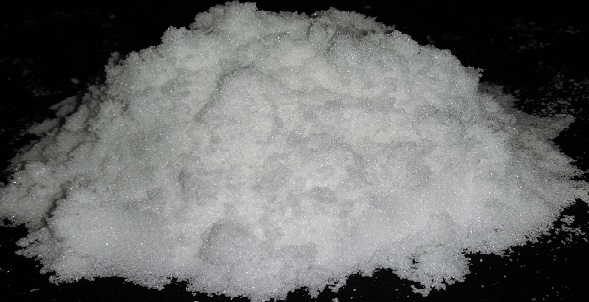Ammonium chloride is an inorganic compound with the chemical formula NH4Cl. It is also known as sal ammoniac. Ammonium chloride is highly soluble in water producing a mildly acidic solution.
Ammonium chloride is mainly used as a nitrogen source in fertilizers like chloroammonium phosphate. Plus, it is used as a flux in preparing metals to be tin-coated, galvanized or soldered.
Characterization of Ammonium chloride

Ammonium chloride is composed of ammonium and chloride ions. It is also known as Sal ammoniac, Salmiac, Nushadir salt, and Salt Armoniack. Ammonium chloride is soluble in water, ethanol, methanol, and glycerol and it is also slightly soluble in acetone. Moreover, it is insoluble in organic solvents such as ethyl acetate. Some properties of this substance include:
- Its molar mass is 49 g. mol-1.
- Its melting point is 338 °C.
- Its boiling point is 520°C.
- Its density is 53 gcm–3
When heated, Ammonium chloride breaks down into ammonia and hydrogen chloride as products. This reaction can be represented by the chemical equation:
NH4Cl(s) → NH3(g) + HCl(g)
Applications of Ammonium chloride
Ammonium chloride has different applications in various industries. In Japan, it is mostly used for fertilizer in rice cultivation. Additionally, it is used in the manufacture of personal cleansing products, medicine, and as a flavouring agent in the food industry. Some uses of Ammonium chloride include:
- It is used in fertilizers, mostly for rice and wheat crops.
- It is used in personal cleansing products. It can be found in shampoo, hair colour, body wash, and facial cleansers.
- It is used as a component in metalwork.
- It is used as a flavouring agent in the food industry. It is used as a food additive and yeast nutrient in the making of bread.
- It is used as an electrolyte in zinc-carbon batteries.
Ammonium chloride Production
Ammonium chloride is the product of the Solvay process.
CO2+2NH3+2NaCl+H2O→2NH4Cl+Na2CO3
In the Solvay process, the sodium bicarbonate is recovered by the filtration process and then, the Ammonium Chloride that remains in solution crystallizes.
Commercially, ammonium chloride is prepared from the combination of ammonia (NH3) with hydrogen chloride (gas) or hydrochloric acid.
NH3+HCl→NH4Cl
Ammonium chloride Storage
Ammonium chloride is hygroscopic and due to this, it should be stored in dry, well-ventilated spaces in tightly closed containers.
It is essential to keep Ammonium chloride separated from ammonium nitrate and potassium chlorate, as well as strong oxidizers such as permanganates, lead and silver salts, Bromium trifluoride, and alkalis and their carbonates, as it can react violently with these substances.
Ammonium chloride Health Hazards
Ammonium chloride is very poisonous and toxic and can cause damage to organs by ingestion. However, it is not harmful under recommended storage conditions.
After exposure to Ammonium chloride, health effects may occur:
- Contact can severely irritate the skin and eyes.
- Inhaling Ammonium chloride can irritate the nose, throat and lungs.
- Exposure to Ammonium chloride may cause headache, vomiting, and confusion.
Proper safety precautions should be followed when handling Ammonium chloride in the workplace to avoid exposure. It is important to train employees on the appropriate handling and storage procedures to prevent accidents.
- Protective clothing, including impermeable gloves and eyewear, should be worn at all times.
- Hands should be washed after handling the chemical.
- Adequate ventilation should be provided in areas where Ammonium chloride is being used or handled.
- In case of contamination, it is recommended to change into clean clothing.
FAQ
What is the most important application of Ammonium chloride?
The main application of ammonium chloride is as a source of nitrogen in fertilizers.
What is Ammonium chloride?
Ammonium chloride is a white crystalline solid. It is the salt of ammonia and hydrogen chloride. Ammonium chloride is used as a nitrogen supply in fertilizers and as an electrolyte in dry cells
Is Ammonium chloride harmful?
Exposure to Ammonium chloride is hazardous. It can cause irritation, shortness of breath, nausea, and headache.
Is Ammonium chloride toxic to humans?
Ammonium chloride may cause an asthma-like allergy. Exposure may affect the kidneys. The recommended airborne exposure limit is 10 mg/m3 averaged over a 10-hour work shift.
What are the advantages of Ammonium chloride fertilizer?
Ammonium chloride is an effective source of both N and Cl. For salty and alkaline soils, Ammonium chloride fertilizer is suitable.
What is the formula of Ammonium chloride?
Ammonium chloride is a chemical compound with the chemical formula NH4Cl.
How much does Ammonium chloride cost per kg?
ArChem Ammonium chloride can be purchased in a variety of volumes. Depending on your orders, prices are different. For more information, please contact our technical sales team in ArChem.
What is the CAS number of Ammonium Chloride?
The CAS number of Ammonium chloride is 12125-02-9.
Is Ammonium chloride flammable?
Ammonium chloride is not combustible. The flammability rating of this product is 0 (no fire hazard).
